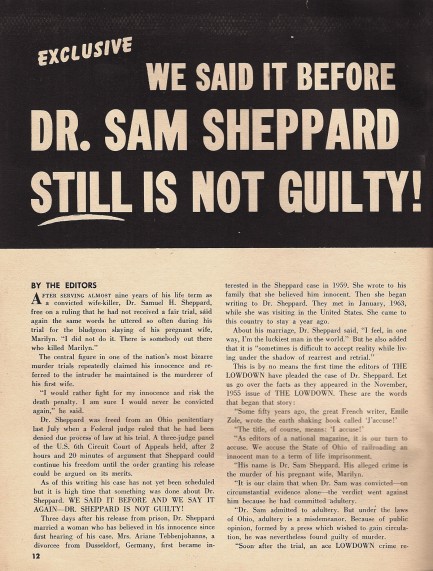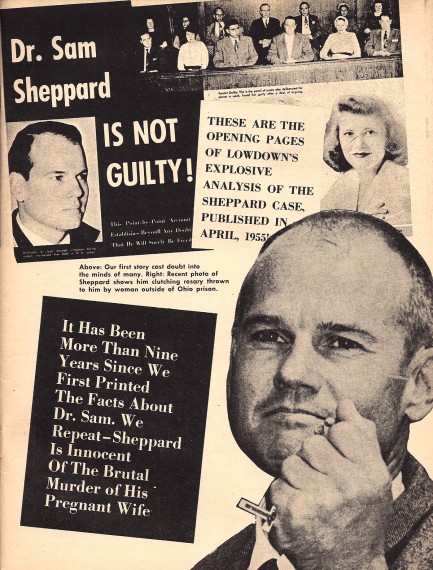 1954 murder results in fifty-year legal battle. 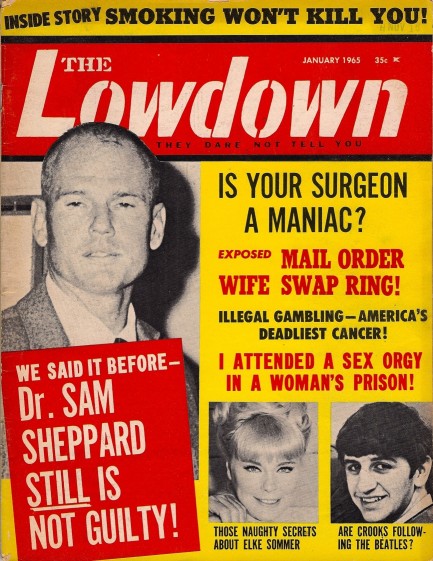
In this January 1965 issue of The Lowdown, editors take up the cudgel for convicted murderer Dr. Sam Sheppard, who was serving a life sentence for the bludgeoning murder of his wife, Marilyn. Dr. Sheppard claimed that, during the early morning hours of July 4, 1954, he was in his home sleeping on a downstairs daybed, when he awoke to his wife’s screams. He ran to her aid and was attacked by a “bushy-haired man” and knocked out. When he came to he chased the man outside, fought him again, and was again knocked out. When he awoke once more, the intruder was gone and his wife was dead, having been severely beaten and apparently sexually assaulted. Police searched for the bushy-haired suspect, but eventually decided their perp was the good doctor himself. At a trial later that year a jury agreed, and Sheppard was sent up for life. By the time Lowdown began advocating for Sheppard, he had already been granted a writ of habeas corpas, and was about to be granted a new trial due to massive publicity surrounding the first that may have tainted the original jury pool. When Sheppard was retried the next year—with none other than a young F. Lee Bailey acting as his defense lawyer—he was acquitted on the basis of reasonable doubt. However, the verdict did not clear Sheppard’s name to the satisfaction of some family members. Efforts to do that continued all the way until 2002, complete with DNA testing on the exhumed corpses of Sheppard, his wife, and her unborn fetus. Results: inconclusive. 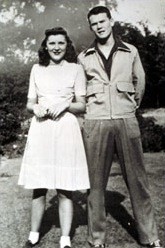 So you must be wondering why police focused on Sheppard in the first place. It wasn’t just because he was the husband, and his marriage was unhappy. Police investigators are very much like statisticians. Certain types of cases share certain traits, and the more traits a particular case shares with a certain category of cases, the more probable a certain conclusion begins to seem. An example: a home invader will nearly always immobilize the gravest threat first, meaning the man of the house; but in a staged domestic murder the man nearly always, somehow, is overlooked by the intruder, leading to a heroic rescue attempt that fails and results in injuries that are, somehow, never life-threatening. Another example: in a staged domestic murder the man will often remove clothing from the victim to imply that the motive was sexual assault by an intruder; but the rape is never consummated, for obvious reasons. So you must be wondering why police focused on Sheppard in the first place. It wasn’t just because he was the husband, and his marriage was unhappy. Police investigators are very much like statisticians. Certain types of cases share certain traits, and the more traits a particular case shares with a certain category of cases, the more probable a certain conclusion begins to seem. An example: a home invader will nearly always immobilize the gravest threat first, meaning the man of the house; but in a staged domestic murder the man nearly always, somehow, is overlooked by the intruder, leading to a heroic rescue attempt that fails and results in injuries that are, somehow, never life-threatening. Another example: in a staged domestic murder the man will often remove clothing from the victim to imply that the motive was sexual assault by an intruder; but the rape is never consummated, for obvious reasons. The list goes on. Suffice it to say, to the cops Marilyn Sheppard's killing seemed like a textbook staged domestic homicide, and they proceeded based on that assumption. But regardless, the evidence was never there for a conviction. Of that, there’s little dispute. Today, Sheppard’s innocence or guilt remains a hot topic in the Ohio town where he lived. And it probably always will be, if only because people there are reminded of the case every time The Fugitive appears on television. That’s right—if certain details of the story seem familiar, it’s because both the series and movie took inspiration from the Sheppard case. And there was one more important result. It catapulted F. Lee Bailey to national prominence as an attorney, a position he has held ever since in defending everyone from Patty Hearst to O.J. Simpson.
 
Above, Natasha Richardson in her bravura 1988 role as Patty Hearst.
 Modern day bad girls are nothing compared to Patty Hearst. 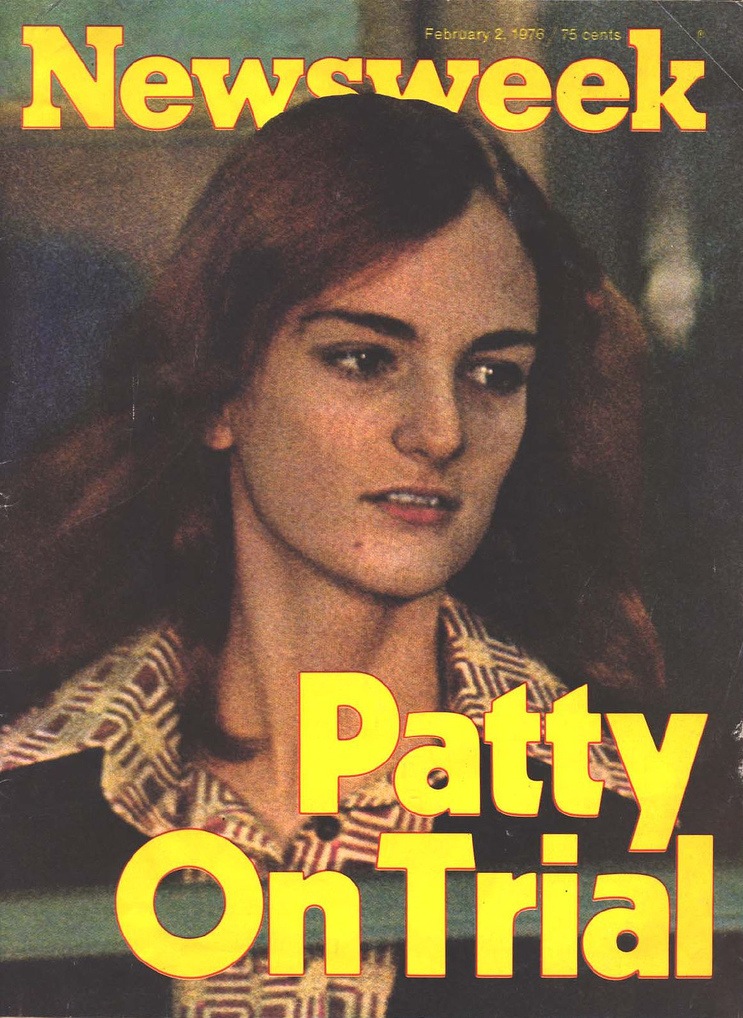
Winona, Paris, Nicole—read and learn. Patty Hearst was first a millionaire socialite, then a kidnap victim, then a self-described urban revolutionary and machine gun toting bank robber. She went on trial for armed robbery in January 1976, and the proceedings continued through March. Newsweek produced the grainy cover you see above twenty-two years ago today. Despite the efforts of celebrity lawyer F. Lee Bailey, Hearst was sentenced to 35 years. But her sentence was commuted by president Jimmy Carter after a mere 22 months of time served, even though she had refused at trial to give evidence against her kidnappers/accomplices. She was later given a full pardon by Bill Clinton. Psychologists claim Hearst was not responsible for her actions due to the effects of Stockholm syndrome, which basically means she started digging her kidnappers. We're gonna try that excuse next time we get arrested, but we have a feeling it won’t work.
 Yes or no on the beret? Too much? Just right? 
Patty Hearst, revolutionary and bank robber, looking pretty comfortable with a gun, 1974.
|
 |

The headlines that mattered yesteryear.
1927—Mae West Sentenced to Jail
American actress and playwright Mae West is sentenced to ten days in jail for obscenity for the content of her play Sex. The trial occurred even though the play had run for a year and had been seen by 325,000 people. However West's considerable popularity, already based on her risque image, only increased due to the controversy. 1971—Manson Sentenced to Death
In the U.S, cult leader Charles Manson is sentenced to death for inciting the murders of Sharon Tate and several other people. Three accomplices, who had actually done the killing, were also sentenced to death, but the state of California abolished capital punishment in 1972 and neither they nor Manson were ever actually executed. 1923—Yankee Stadium Opens
In New York City, Yankee Stadium, home of Major League Baseball's New York Yankees, opens with the Yankees beating their eternal rivals the Boston Red Sox 4 to 1. The stadium, which is nicknamed The House that Ruth Built, sees the Yankees become the most successful franchise in baseball history. It is eventually replaced by a new Yankee Stadium and closes in September 2008. 1961—Bay of Pigs Invasion Is Launched
A group of CIA financed and trained Cuban refugees lands at the Bay of Pigs in southern Cuba with the aim of ousting Fidel Castro. However, the invasion fails badly and the result is embarrassment for U.S. president John F. Kennedy and a major boost in popularity for Fidel Castro, and also has the effect of pushing him toward the Soviet Union for protection.
|

|
|

It's easy. We have an uploader that makes it a snap. Use it to submit your art, text, header, and subhead. Your post can be funny, serious, or anything in between, as long as it's vintage pulp. You'll get a byline and experience the fleeting pride of free authorship. We'll edit your post for typos, but the rest is up to you. Click here to give us your best shot.

|
|


 So you must be wondering why police focused on Sheppard in the first place. It wasn’t just because he was the husband, and his marriage was unhappy. Police investigators are very much like statisticians. Certain types of cases share certain traits, and the more traits a particular case shares with a certain category of cases, the more probable a certain conclusion begins to seem. An example: a home invader will nearly always immobilize the gravest threat first, meaning the man of the house; but in a staged domestic murder the man nearly always, somehow, is overlooked by the intruder, leading to a heroic rescue attempt that fails and results in injuries that are, somehow, never life-threatening. Another example: in a staged domestic murder the man will often remove clothing from the victim to imply that the motive was sexual assault by an intruder; but the rape is never consummated, for obvious reasons.
So you must be wondering why police focused on Sheppard in the first place. It wasn’t just because he was the husband, and his marriage was unhappy. Police investigators are very much like statisticians. Certain types of cases share certain traits, and the more traits a particular case shares with a certain category of cases, the more probable a certain conclusion begins to seem. An example: a home invader will nearly always immobilize the gravest threat first, meaning the man of the house; but in a staged domestic murder the man nearly always, somehow, is overlooked by the intruder, leading to a heroic rescue attempt that fails and results in injuries that are, somehow, never life-threatening. Another example: in a staged domestic murder the man will often remove clothing from the victim to imply that the motive was sexual assault by an intruder; but the rape is never consummated, for obvious reasons.